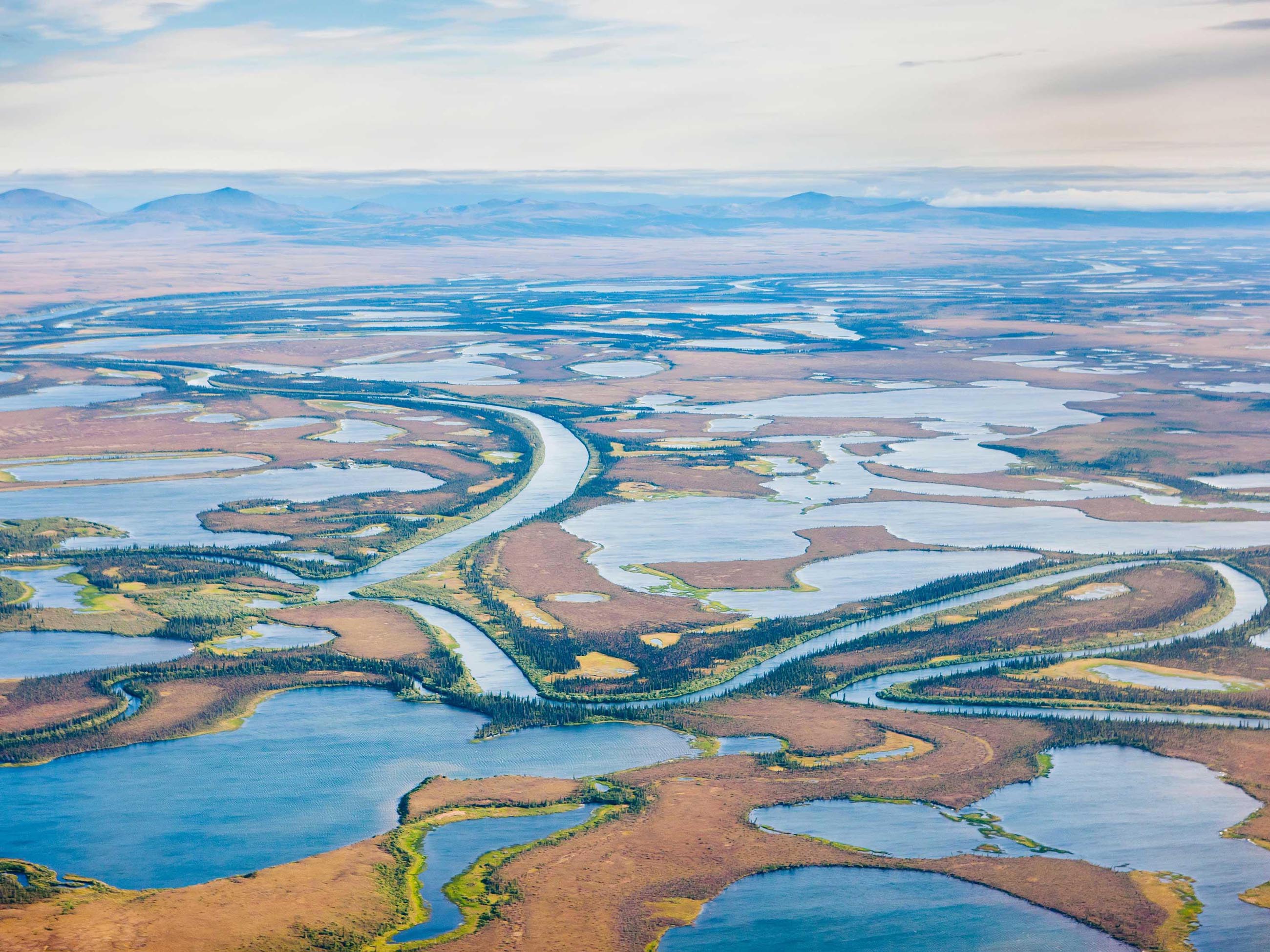Selawik National Wildlife Refuge
Encompassing a transition zone, this refuge weaves together boreal forest, Arctic tundra, wetlands, and hot springs.
Selawik National Wildlife Refuge is situated in remote northwestern Alaska on the Arctic Circle to the east of Kotzebue Sound. The 2.15-million-acre refuge encompasses an Arctic landscape rich in cultural heritage and natural beauty.
The refuge is an awe-inspiring land of vast tundra, spruce forest, and birch and alder-lined foothills. Its sweeping waterways and wetlands give shelter and provide habitat for a wide array of migratory and resident birds and mammals. The Waring Mountains and Kobuk Valley National Park border the refuge on the north, and to the south are the Selawik Hills and Purcell Mountains.
THINGS TO DO
The Selawik Wilderness Area has no trails or public facilities. Summer access is difficult due to the area’s remoteness and rough topography. The nearest town is Kotzebue, where visitors can arrange transportation by charter air service to remote locations in the refuge for hunting, fishing, hiking, wildlife viewing, photography, and other backcountry activities.
The refuge's Wilderness adjoins the 190,000-acre Kobuk Valley Wilderness in the Kobuk Valley National Park. Hiking in from the Kobuk Sand Dunes is one way to access the Selawik Wilderness Area. While hiking, visitors can enjoy viewing and photographing wildlife and vast landscapes.
Selawik Hot Springs is an enjoyable destination for locals and visitors to the area in the winter months. The hot springs are accessible only when there is snow cover, with most visitors arriving by snowmobile from the villages of Shungnak or Huslia, 50-60 miles away. There are no established roads or trails to the hot springs. Primary access is by snowmobile, although dogsledding and skiing are also options. There are two public cabins and a bathhouse at the hot springs.
WILDLIFE
One of the main reasons the refuge was created was for the protection of the Western Arctic caribou herd, the largest herd in Alaska at about 500,000 animals. The Western Arctic caribou migrate through the refuge on their way from calving to wintering grounds. Other large mammals on the refuge include moose, which began using the refuge in the 1940s, and occasionally muskoxen. Both black and grizzly bears are present, as are wolves, Arctic and red fox, lynx, wolverine, beaver, and marten.
The Selawik and Kobuk River deltas also provide invaluable habitat for hundreds of thousands of migratory bird species. During the short Arctic summers, large numbers of white-fronted geese and majestic tundra swans arrive along with sandhill cranes and a horde of other shorebirds. Large populations of sheefish and other whitefish inhabit the waters of the refuge with some sheefish approaching 60 pounds.
LANDSCAPE
The refuge covers a transition zone, where the northernmost boreal forest gives way to Arctic tundra, lakes, wetlands, and meadows. Selawik's landscape is so diverse it even includes a set of rolling, vegetated sand dunes that were formed by the last glacial recession. These dunes are the remnant of a much larger system that once included the Great Kobuk Sand Dunes to the north. Most of this habitat is tundra, with approximately 24,000 lakes and wetlands.
HISTORY
Northwest Alaska has played a key role in North American history as a travel route, a home for northern peoples, a trapping ground, and as a reindeer herding area. Historically, the Kobuk and Selawik Rivers served as important travel corridors from the coast to the more mountainous areas to the east. This is still true today, as locals access these lands via waterways by boat in the summer and by snowmobile or dog team in the winter.
Like many other National Parks, Preserves, and Refuges, the Selawik Refuge was officially established in 1980 with the passage of the Alaska National Interest Lands Conservation Act. This land designation and subsequent management by the U.S. Fish and Wildlife Service is the most recent chapter in the long history of this northern landscape.
FACILITIES AND CAMPING
There are no roads, maintained trails, campgrounds, or visitor facilities in Selawik National Wildlife Refuge. The exception is the hot springs at the headwaters of the Selawik River, where there are two rustic public cabins and a bathhouse. The Upper Kobuk Elders’ Council and the City Council of Huslia hold a special use permit for these facilities, but the public is welcome to use the cabins if unoccupied. Backcountry camping is permitted.
GETTING HERE
Selawik National Wildlife Refuge is not accessible by road. Most visitors access the refuge by chartered air service from Kotzebue. Daily flights are available from Anchorage to Kotzebue. In winter, visitors can access the refuge by dogsleds or snowmobiles.
Explore more things to do in Kotzebue.
For more information, visit the Selawik National Wildlife Refuge website.

Local Climate & Weather
For Alaska's day-to-day weather, it’s best to plan for a bit of everything. Learn more about weather in this area.
Travel Inspiration
#TravelAlaska
#TravelAlaska
 @seth.d.adams
@seth.d.adams
 @lucmehl
@lucmehl
 @tumbleweedsouls
@tumbleweedsouls
 @animalabis
@animalabis
 @ontheroadtogether.online
@ontheroadtogether.online


